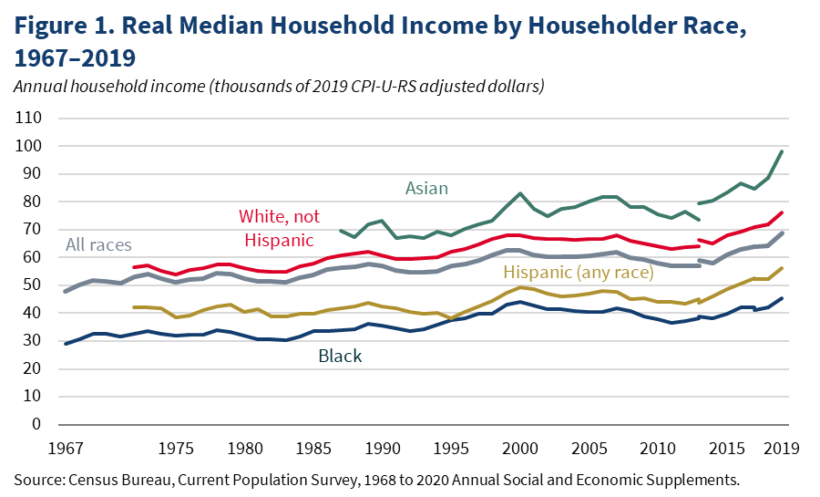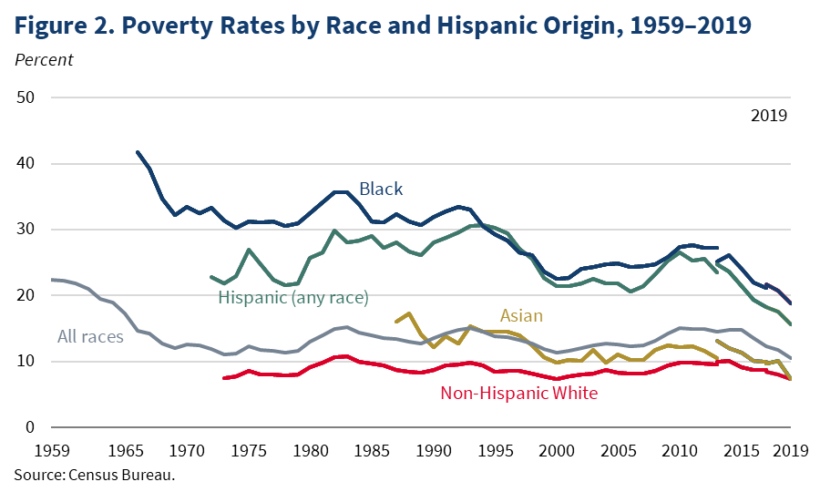Data released by the Census Bureau today show that 2019 was a historic year for raising Americans’ living standards. Real median household income reached a record high, and poverty reached a record low. Improvements in income and poverty were the largest in over 50 years. Minority groups—including black, Hispanic and Asian Americans—experienced the largest gains.
Median income reaches all-time high after largest one-year increase on record
Real median household income increased by $4,400 in 2019, reaching an all-time record high of $68,700. This represents a 6.8 percent one-year increase, which is the largest one-year increase in median income on record. Since 2016, real median household income has increased by 9.7 percent (after adjusting for a Census survey redesign in 2017).
Income gains in 2019 were largest for minority groups. Real median income grew by 7.9 percent for black Americans, 7.1 percent for Hispanic Americans, and 10.6 percent for Asian Americans (see Figure 1). These one-year increases were all record highs, and the new income levels reached in 2019 were all record highs, as well.

As incomes grew, income inequality fell for the second consecutive year. Between 2017 and 2019, the Gini index of income inequality fell from 0.489 to 0.484. Over the same two-year period, the share of income held by the top 20 percent fell by 0.4 percentage points.
The rise in income was driven by an increase in the number of workers, especially women. There were 2.2 million more people working at some point in 2019 compared with 2018, and 1.2 million more people working full-time year-round. The full 1.2 million increase in full-time year-round workers was attributable to women.
Poverty hits record low after largest decrease in over 50 years
Incomes grew across the distribution, and poverty plummeted as a result. The official poverty rate fell to an all-time record low of 10.5 percent in 2019. Over 4 million people were lifted out of poverty between 2018 and 2019 for a 1.3 percentage point decrease. This was the largest reduction in poverty in over 50 years.
Minority groups led the way in poverty alleviation. Compared to the overall poverty rate reduction of 1.3 percentage points, black poverty fell by 2.0 percentage points, Hispanic poverty fell by 1.8 percentage points, and Asian poverty fell by 2.8 percentage points (see Figure 2). The poverty rate fell to an all-time record low for every race and ethnic group in 2019. Notably, the black poverty rate fell below 20 percent for the first time in history.

Children fared even better than the overall population. Child poverty fell to a near 50-year low in 2019, falling by 1.8 percentage points to 14.4 percent. Since 2016, 2.8 million children have been lifted out of poverty, including over 1 million Hispanic children.
The reduction in poverty during the Trump Administration is unprecedented. Between 2016 and 2019, 6.6 million people were lifted out of poverty, the largest 3-year reduction to start any presidency since the initial drop that began the War on Poverty in 1964. The 1.2 million black Americans lifted out of poverty since 2016 is also the largest reduction on record—spanning over 50 years—for the first 3 years of any President’s administration.
Data collection issues due to COVID-19
It is important to note that data collection efforts for the income and poverty estimates were affected by COVID-19. The response rate fell by about 10 percentage points as households became more difficult to reach. Despite these issues, the data quality met usual Census Bureau standards. In addition, Census Bureau research suggests that even after accounting for potential issues with response rates, real median income still would have increased and poverty still would have decreased by large magnitudes.
Pro-Growth Policies Work
The Census Bureau’s income and poverty estimates for 2019 show what’s possible under the Trump Administration’s pro-growth policies. With over 2 million new workers in 2019—fueled by female full-time, year-round workers—incomes grew at the highest pace ever recorded. As incomes grew, poverty fell to an all-time low. The one-year poverty rate decrease was the largest in over 50 years. Minority groups experienced the largest improvements—and for the first time ever, fewer than one in every five black Americans suffers from poverty.
The COVID-19 pandemic disrupted this historic progress in 2020. But the strong recovery has vastly outperformed expectations, and almost half of the jobs lost by April had already returned by August. While the recovery is far from complete with millions of Americans still out of work, the Census Bureau’s latest income and poverty numbers have set a new standard: 2019 was the best year for household economic gains in half a century in America. Under the Trump Administration’s pro-growth policies, this standard can be achieved again.

